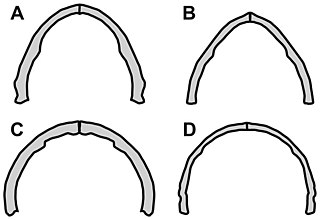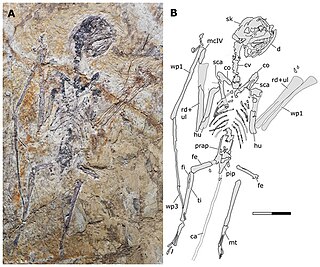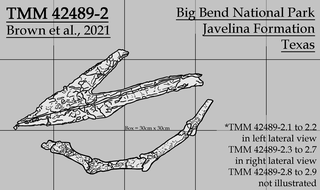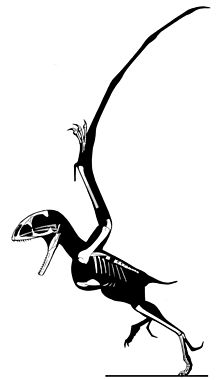
Dsungaripterus is a genus of dsungaripterid pterosaur with an average wingspan of 3 meters (9.8 ft). Dsungaripterus lived during the Early Cretaceous in what is now China, and its first fossil was found in the Tugulu Group the Junggar Basin.

Pterosaurs are an extinct clade of flying reptiles in the order Pterosauria. They existed during most of the Mesozoic: from the Late Triassic to the end of the Cretaceous. Pterosaurs are the earliest vertebrates known to have evolved powered flight. Their wings were formed by a membrane of skin, muscle, and other tissues stretching from the ankles to a dramatically lengthened fourth finger.

Jeholopterus was a small anurognathid pterosaur known from the Middle to Late Jurassic Daohugou Beds of the Tiaojishan Formation of Inner Mongolia, China, and possibly the Early Cretaceous Sinuiju Formation of North Korea.

Anurognathus is an extinct genus of small pterosaur from the Late Jurassic Altmühltal Formation of Germany.

Anurognathidae is a family of small, short-tailed pterosaurs that lived in Europe, Asia, and possibly North America during the Jurassic and Cretaceous periods. Five genera are known: Anurognathus, from the Late Jurassic of Germany; Jeholopterus, from the Middle to Late Jurassic of China; Dendrorhynchoides, from the Middle Jurassic of China; Batrachognathus, from the Late Jurassic of Kazakhstan; and Vesperopterylus, from the Early Cretaceous of China. Bennett (2007) suggested that the holotype of Mesadactylus, BYU 2024, a synsacrum, belonged to an anurognathid, though this affinity has been questioned by other authors. Mesadactylus is from the Late Jurassic Morrison Formation of the United States. Indeterminate anurognathid remains have also been reported from the Middle Jurassic Bakhar Svita of Mongolia and the Early Cretaceous of North Korea.
Brasileodactylus a genus of pterosaur from the Aptian-age lower Santana formation of Chapada do Araripe, Ceará, Brazil.

Dendrorhynchoides was a genus of anurognathid pterosaur containing only the holotype species D. curvidentatus that is known from the Middle Jurassic Tiaojishan Formation of Qinglong, northern Hebei Province, China.

Feilongus is an extinct genus of ctenochasmatid pterodactyloid pterosaur from the Barremian–Aptian-age Lower Cretaceous Yixian Formation of Beipiao, Liaoning, China.

Pterorhynchus is an extinct genus of pterosaur from the mid-Jurassic aged Daohugou Formation of Inner Mongolia, China.

Nurhachius is a genus of istiodactylid pterodactyloid pterosaur from the Barremian to Aptian-age Lower Cretaceous Jiufotang Formation of Chaoyang, Liaoning, China. Its fossil remains date back about 120 million years ago.

Liaoningopterus, sometimes misspelled as "Liaoningopteryx", was a genus of anhanguerid pterodactyloid pterosaur from the Barremian-Aptian-age Lower Cretaceous Jiufotang Formation of Chaoyang, Liaoning, China.
Elanodactylus is a genus of ctenochasmatid pterodactyloid pterosaur from the Early Cretaceous period of what is now the Yixian Formation of Liaoning, China.

Lacusovagus is a genus of azhdarchoid pterodactyloid pterosaur from the Lower Cretaceous of Brazil. It is based on SMNK PAL 4325, a partial upper jaw comprising sections of the skull in front of the eyes. This specimen was found in rocks of the Early Cretaceous-age Nova Olinda Member of the Crato Formation. The skull was long, and unusually wide. The section in front of the combined nasal-antorbital fenestra was relatively short. Also unusual was the combination of its toothless jaws and no bony head crest. Lacusovagus was described in 2008 by Mark Witton. The type species is L. magnificens, meaning "grand lake wanderer", in reference to its large size—it is currently the largest pterosaur known from the Crato Formation with an estimated wingspan of approximately 4 metres (13 ft) and a body mass of 30 kg (66 lb).

The Tiaojishan Formation is a geological formation in Hebei and Liaoning, People's Republic of China, dating to the middle-late Jurassic period. It is known for its exceptionally preserved fossils, including those of plants, insects and vertebrates. It is made up mainly of pyroclastic rock interspersed with basic volcanic and sedimentary rocks. Previously, the Tiaojishan Formation was grouped together with the underlying Haifanggou Formation as a single "Lanqi Formation." The Tiaojishan Formation forms a key part of the Yanliao Biota assemblage, alongside the Haifanggou Formation.

Carniadactylus is a genus of pterosaur which existed in Europe during the Late Triassic period. The genus contains a single species, Carniadactylus rosenfeldi.

Vesperopterylus is a genus of anurognathid pterosaur from the Early Cretaceous Jiufotang Formation of China, the geologically youngest member of its group. Notably, Vesperopterylus appears to have a reversed first toe, which would have been suited for gripping; it was likely arboreal, climbing or clinging to tree branches with curved, sharp claws. It also has a relatively short tail, in contrast with its tailless (Jeholopterus) and long-tailed (Dendrorhynchoides) relatives. It was first described and named by Lü Junchang et al. While the original spelling of the name was Versperopterylus, this was a typo, and was emended by the authors in accordance with the International Code of Zoological Nomenclature.
Luopterus is an extinct genus of anurognathid pterosaur containing only the holotype species L. mutoudengensis that is known from the Middle Jurassic Tiaojishan Formation of Qinglong, northern Hebei Province, China. It was originally named as a species of Dendrorhynchoides in 2012 but it was moved to the genus Luopterus in 2020. Luopterus was originally thought to be from the Early Cretaceous, with a wingspan that is about 40 centimeters (16 in), making it one of the smallest known pterosaurs.

Sinomacrops is a genus of extinct anurognathid pterosaur from the Middle to Late Jurassic periods of what is now the Daohugou Beds of the Tiaojishan Formation in Mutoudeng, Qinglong County of the Hebei province. The remains of Sinomacrops date back to around 164 to 158 million years ago. The type and only known species is Sinomacrops bondei.

Wellnhopterus is an azhdarchid pterosaur recovered from the Late Cretaceous Javelina Formation in Texas that was previously identified as a thalassodromine. It consists of a set of upper and lower jaws, as well as some cervical vertebrae and a fragmentary long bone. In July 2021, the jaws were given the genus name "Javelinadactylus", with the type and only species as "J. sagebieli"; however, this article has now been retracted. In a paper published in December 2021, the complete holotype was independently named Wellnhopterus, with the only species being W. brevirostris. As of 2022, this is the formal name of this pterosaur.
Cascocauda is an extinct genus of anurognathid pterosaur from the Late–Middle Jurassic Tiaojishan Formation of Hebei Province, China. The genus contains a single species, C. rong, known from a complete skeleton belonging to a juvenile individual preserved with extensive soft-tissues, including wing membranes and a dense covering of pycnofibres. Some of these pycnofibres appear to be branched, resembling the feathers of maniraptoran theropod dinosaurs, and suggesting that pterosaur pycnofibres may be closely related to feathers in dinosaurs.






























